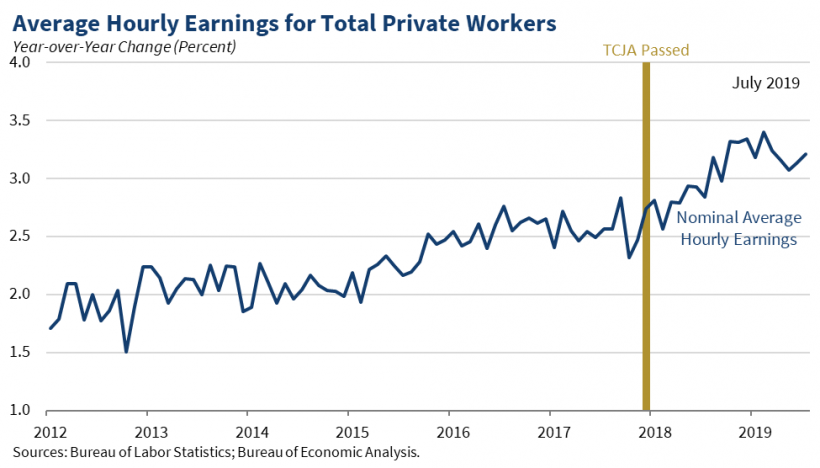The Bureau of Labor Statistics (BLS) released its monthly Employment Situation Report, showcasing robust employment and an acceleration in wage growth. Total nonfarm payroll employment in July increased by 164,000 jobs, in line with market expectations (165,000). Including revisions for the months of May and June, the average pace of job growth has been a vigorous 187,000 jobs per month over the past year and 165,000 jobs so far in 2019, which is higher than CBO or the Federal Reserve anticipated for this cycle. The 12-month average remains above the 2017 average of 179,000 jobs gained per month. In total, the economy has added over 6.2 million jobs since the President was elected.

The July jobs report revealed yet another month of strong job growth. Since the President was elected, job gains have surpassed 100,000 jobs in 29 of the 32 months. The average job growth over the past 6 months is a healthy 141,000 jobs. Considering the unprecedented length of the expansion, job gains are strong. In July 2019, just over 6 million people were unemployed, compared with more than 14 million in July 2009 at the beginning of the economic expansion. Given low unemployment, monthly job gains of this size indicate that the labor market is truly flourishing.
Education and health services industry led job growth in July adding 66,000 jobs. The professional and business services sector saw the second largest job growth, an increase of 38,000 jobs. Manufacturing jobs increased as well, gaining 16,000 jobs in July, including 7,200 jobs in motor vehicle and parts manufacturing. Since the President’s election, the manufacturing industry has added 523,000 jobs and added 157,000 jobs in the past 12 months.
In July, wages continued to grow as well. Nominal average hourly earnings rose 3.2 percent over the past 12 months, marking the 12th straight month that year-over-year wage gains were at or above 3 percent (see figure). Prior to 2018, nominal average hourly wage gains had not reached 3 percent in over 10 years (since April 2009). Nominal wage growth has accelerated since the passage of the Tax Cuts and Jobs Act (TCJA). When taking inflation into account, there is evidence that real wages are also growing. Based on the most recent Personal Consumption Expenditures (PCE) price index data from June, inflation in the past year was 1.4 percent, and based on the most recent Consumer Price Index (CPI-U) price data from June, the inflation in the past year was 1.6 percent (July inflation data is not yet available for either series).
A separate household survey released by BLS shows that the unemployment rate remained at 3.7 percent in July, making July the 17th consecutive month at or below 4 percent. The labor market also continues to benefit all Americans. The African American unemployment rate remained at 6.0 percent, just above the historic low of 5.9 percent set in May 2018, and the African-American teen unemployment rate dropped to its lowest rate since the series began in 1972. The U-6 unemployment rate, which is a broader measure of underutilization in the labor market that includes those looking for work, marginally attached to the labor force, and part-time for economic reasons, hit 7.0 percent, its lowest point since 2000.
The labor force participation rate—which includes people who are working and those looking for work—edged up by 0.1 percentage point to 63.0 percent and is 0.3 percentage point above the rate when the President was elected in November 2016. The labor force participation rate for prime-age adults (ages 25-54), which largely avoids the demographic effects of the aging population, decreased by 0.2 percentage point to at 82.0 percent—0.6 percentage point above its rate in November 2016.
The Trump Administration’s pro-growth policies continue to pull workers off the sidelines and foster a prosperous economy. Despite the continued low unemployment rates over the past year, there may still be workers on the sidelines, a situation economists refer to as “labor slack.” Because labor market slack still exists, employment can continue to rise and the economy can continue to grow as workers reenter the labor force. In July, 73.8 percent of workers entering employment came from out of the labor force rather than from unemployment.
The July employment data demonstrate that the American economy remains strong, with a consistently low unemployment rate, strong wage growth, and robust job gains.
